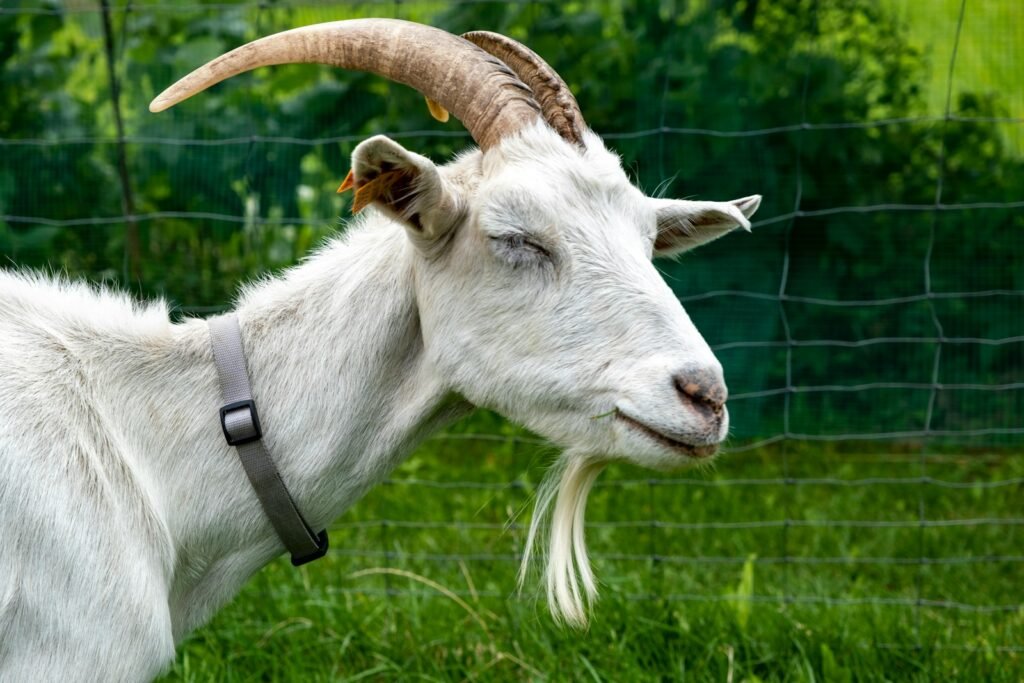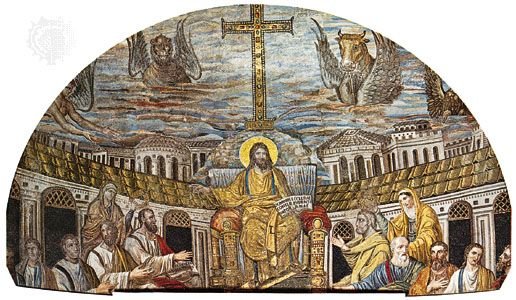“When the Son of Man comes in his glory, and all the angels with him, he will sit on his glorious throne. All the nations will be gathered before him, and he will separate the people one from another as a shepherd separates the sheep from the goats.” – Matthew 25:31-32 (NIV)
What does goat symbolize in the Bible? Goats are a big symbol in the Bible. They stand for parts of human nature and spirituality. They differ from sheep, showing the unrighteous side. Goats are known from biblical stories for their use in sacrifices and in judgment.
In Genesis, goats symbolize power and life. Jacob used them cleverly to grow his flock. They were very special livestock, showing their importance in the Bible.
Moreover, goats were important in sacrifices to clear sins. In Leviticus, they were chosen to bear the people’s sins. This act was key for people to be forgiven and to clear their guilt.
Also, goats helped build the Tabernacle. Their hair was used for tents and curtains. This shows their role as both practical and symbolic in religious activities.
While goats were okay for eating and for sacrifices, they got a bad rap too. They were seen as a bit disagreeable, always doing their own thing. Yet, the Bible also sees them in a positive way. It emphasizes their role as leaders with courage and dignity.
One very famous story about goats in the Bible is from Matthew 25. It tells about the Sheep and the Goats. This story stresses treating others with care. It says that how you treat others shows your love for Christ.
The Bible’s take on goats is pretty balanced. It praises their leadership but also warns against not caring for others. It suggests that we should be humble, obedient, and thoughtful in our journey of faith. This is the lesson from goats’ known unpredictable nature.
The Symbolism of Goats in the Bible
In the Bible, goats are important symbols. They often stand for unrighteousness and power. They contrast with sheep, the symbol of the righteous. Goats are key in many Bible stories, showing their deep symbolic meaning.
A well-known story is the sheep and goats parable in Matthew 25:31-46. Here, goats represent the unrighteous who are separated from the righteous. It stresses the need to be kind and help others. It also warns of a harsh judgment for those who turn away from those in need.
In the Old Testament, goats had a role in sacrificial offerings. Their blood helped with atonement, linking them to forgiveness of sins. Goat hair was also used in the Tabernacle, underscoring their religious importance.
Throughout the Bible, goats often symbolize evil, judgment, and sin. The sheep and goat parable underlines this, showing goats as the unrighteous facing judgment. In this common context, goats are seen as symbols of negativity.
The book of Daniel uses goats to represent historical and powerful kingdoms. For instance, a goat with a horn represents Alexander the Great and the Greek kingdom. This gives insights into the future of powerful empires.
“Scripture views goats less positively compared to sheep, possibly due to goats being offensive, going off in their own direction to achieve goals, and often accompanied by ego.” [The Male Goat]
Goats are often seen as capricious and independent animals. They are known for escaping and leading rather than following. In comparison, sheep are docile, following their shepherd. This symbolism highlights the importance of following a good leader.
Christians should avoid acting like goats. Traits like going against the norm, wanting independence, or trying to lead can pose spiritual risks. They go against biblical teachings.
Their symbolic importance continues in the Old Testament rituals. At Yom Kippur, two goats were significant for their role in sin forgiveness. They symbolized removing guilt from the people.
While goats are important in the Bible, they are also linked with negative things outside it. In Satanism and pagan faiths, the goat is linked to evil and witchcraft. This is seen in the Baphomet, which has a goat’s head.
Overall, the Bible uses goats to convey different meanings. These include unrighteousness, judgment, sacrifice, and power. Understanding these symbols deepens our grasp of Biblical stories and themes.

Goats in the Parable of the Sheep and Goats
The Parable of the Sheep and Goats talks about how people will be separated. Those who helped others are seen as sheep. They will be with God in paradise. The goats, who didn’t help, will face punishment. They are not welcome in paradise.
This story shows us what we should do. We must help those who are hungry, thirsty, strangers, or in need. Jesus says helping these people is like helping Him.
“For I was hungry and you gave me something to eat, I was thirsty and you gave me something to drink, I was a stranger and you invited me in, I needed clothes and you clothed me, I was sick and you looked after me, I was in prison and you came to visit me.” – Matthew 25:35-36
Matthew 24-25 often speaks about separating good and bad. Jesus is the judge who decides where we go based on our actions towards others.
Jesus is like a shepherd, sorting us like sheep and goats. Sheep care for those in need. They stay with the flock. This shows those who truly love and help others. Goats, on the other hand, are independent. They don’t help and are not with God.
“Then he will say to those on his left, ‘Depart from me, you who are cursed, into the eternal fire prepared for the devil and his angels. For I was hungry and you gave me nothing to eat, I was thirsty and you gave me nothing to drink, I was a stranger and you did not invite me in, I needed clothes and you did not clothe me, I was sick and in prison and you did not look after me.'”
– Matthew 25:41-43
Not helping those in need makes you like the goats. Goats do what they wish. But the goats in this story didn’t help the less fortunate. They will be punished.
The story also teaches us to take care of the poor and suffering. God’s judgment is fair but sometimes slow. He waits for us to change and do better.
This tale tells us to love those who are hard to love. It urges us to care for the forgotten. By doing this, we show we truly love God.
Goats in Sacrificial Practices
In the Old Testament, goats played a big role in sacrifices. They symbolized removing sin from people. Practices existed to ask for forgiveness and to cleanse guilt. In Leviticus 16:15, goats were key in offering sacrifices to clear sins.
Also, goats were linked to riches and luck. That’s why they were given to God in offerings. They showed the plenty and benefits people wished for. Goats also helped practically by providing hair for the Tabernacle’s curtains and coverings, as seen in Exodus 26:7.
The role of goats in sacrifices was crucial. They symbolized sin transfer, providing the chance for forgiveness and guilt cleansing. The people aimed to please the Lord and find sin forgiveness through their sacrifice.
Learning about what goats symbolized offers more meaning to the Bible’s stories. It explains themes like forgiveness and getting right with God. These insights show how important these acts were in looking for God’s blessing and healing.
Goats in the Old Testament
In the Old Testament, goats were very important. They were used for sacrifices and for eating. Goats also helped build religious places like the Tabernacle.
By being part of sacrifices, goats helped the people’s sins be forgiven. There was a special ceremony with two goats. One goat took the people’s sins away by being led into the wilderness. This showed the big role goats played in people’s spiritual lives.
Goats also helped build the Tabernacle. Their hair was used for making the tent and curtains. This shows how deeply goats were connected to religious life.
As a symbol, goats represented wealth and success. Offering goats to God showed gratitude for the blessings in life.
However, goats were not always seen as good. They were linked to being stubborn and selfish in the Bible. Unlike sheep, who follow their shepherd, goats would rather do their own thing.
“A well-trained goat, known as a ‘Judas,’ leads sheep to slaughter, highlighting the independent and potentially harmful nature of goats.”
These ideas about goats in the Old Testament tell us a lot. They deepen our understanding of the Bible and its messages. We learn how important goats were in religious and spiritual life.
The Scapegoat Ritual
The scapegoat ritual goes way back to ancient times and is very important in religious ceremonies. It’s described in Leviticus 16 in the Bible as part of the Day of Atonement. In this ceremony, two goats are chosen. One is used for a sin offering, and the other acts as a scapegoat.
The High Priest plays a key role in the ritual. He puts his hands on the scapegoat, sending the people’s sins to it. This symbolizes taking the sins away from the people. Then, the scapegoat is sent into the wild, carrying the sins with it.
This ritual helps in making up for wrongs and starting fresh with the divine. It was a very serious event. Those who took part, especially the Priest and the goat leader, had to be clean and follow special rules. They had to wash thoroughly afterward.
Symbolism of the Scapegoat Ritual
The scapegoat ceremony is full of deep meanings. It shows how everyone is responsible for their sins and the importance of forgiveness. By selecting two goats, the message of atonement is clear. One is sacrificed for the sins, while the other carries them away.
The random choice of who goes where adds a layer of divine plan to the ritual. Putting hands on the scapegoat is a powerful act. It moves the sins from the people to the goat, allowing their sins to be washed away.
This ceremony also points to Jesus. In Christianity, Jesus is the ultimate scapegoat. He takes on everyone’s sins, offering a way for humanity to be forgiven and start anew.
In summary, the scapegoat ritual is rich in meaning. It reminds us of our constant need for forgiveness and a chance to begin again.
Goats and Sheep: Symbolic Differences
In the Bible, goats and sheep have symbolic differences that teach deeper spiritual lessons. Sheep are seen as obedient and rely on their shepherd, symbolizing the righteous. In comparison, goats are known for being independent, stubborn, and prone to causing destruction. This makes them a symbol for the nonbelievers and unrighteous.
The difference between sheep and goats shows the split between true and false believers within the church. Sheep follow their shepherd closely, showing believers’ trust in and obedience to Christ. In contrast, goats prefer to go their own way, reflecting self-will and a defiance of authority.
The parable in Matthew 25:31–46 is crucial. It showcases how sacrificial love earmarks true Christians, according to the shepherd in this story. It is not the sacrificial love itself, but what it shows about their inner character that matters.
Another notable aspect is that sheep have been selectively bred for their wool, while goats have not had similar treatment. This reflects how sheep have become more dependent, whereas goats remain curious and self-sufficient.
“A key difference highlighted is that sheep are led by their shepherd, while goats tend to go their own way.”
The Role of Shepherds and Goatherds
Shepherds protect sheep from dangers and provide for their needs, showing the sheep’s dependent nature. On the other hand, goatherds guard against the environmental damage goats might cause. This showcases the goat’s ability to seek food and water on their own.
Looking at sheep and goats in biblical symbolism reveals a deeper message. To be a sheep means to have a soft, obedient spirit. In contrast, goats symbolize those who act out of defiance and self-will. It’s about the internal nature and choices of an individual.
Believers are urged to adopt the sheep-like spirit. This involves regularly studying the Bible, praying, and reflecting to better hear and follow God’s voice. Embodying the qualities of a sheep helps followers of Christ resemble the righteousness the Bible praises.
The Parable of the Sheep and Goats in Matthew
In Matthew 25:31-46, there’s a parable about sheep and goats. Jesus uses them to show the final judgment of nations. The sheep stand for the righteous, while the goats are those who did not help others.
The sheep are praised for feeding the hungry and helping strangers. They showed love to people in need, which Jesus saw as helping Him. Their kind acts were signs of their faith.
The goats, however, are found wanting for not helping others. They face punishment. Jesus says they are going where “the fire is prepared” because they didn’t help Him when He was in need.
This story teaches a key lesson: faith in Jesus is crucial. Good deeds are important, but they don’t save people on their own. It’s faith first, then good works follow.
The story doesn’t say if there were more sheep or goats. Instead, it shows why helping others is essential. Jesus highlights the care we show to those in need as vital for our faith.
The parable mentions the ‘fruit of the Spirit’, like love and kindness. They should naturally lead Christians to do good deeds. These good actions show a real connection with Christ.
This parable has been read in different ways over time. Since 1850, many see it as a call to help the less fortunate. This new understanding changed how people see the text.
This story might seem critical of the goats, or the unrighteous. Yet, goats were actually quite valuable animals to the ancient Jews. They were seen as useful in everyday life. The tale uses them to make a point, not to devalue them.
In the end, this story is about love and service. It teaches that our treatment of others is a clear sign of our faith. Genuine love and kindness show a heart that has truly accepted Christ’s love and grace.
The Association of Goats with Evil
Goats have been linked with evil in many religions and occult beliefs. This includes Pagan, Norse, and Greek worship. They saw goats as things to fear, pointing to their significant negative role throughout history. This view is tied to the Bible’s ideas, where goats are often seen as unrighteous and facing judgment.
In Jewish tradition, goats took part in a ceremony that connected them to evil. On the Day of Atonement, two goats were involved. One goat bore the sins of the people and was known as the azazel goat. This practice further tied goats to evil in Jewish beliefs.
Depicting Satan as goat-like has also solidified this idea. Many faiths and Satanism portray Satan as a goat. The choice of goats as a demonic symbol with themes of independence, destruction, and leading astray reinforces the link between goats and malevolence.
Goats, in some settings, stand for strength and fertility. Yet, biblical text generally shows them in a negative manner. For example, a Bible story about sheep and goats uses goats to represent the unethical. In this story, sheep stand for the faithful and caring people.
This view draws on biblical themes where goats mean unrighteousness and judgment. It shows the bigger picture of light versus dark choices. And it acts as a lesson, pointing where wrong choices can lead.
The Role of Goats in Occult Practices
Historically, goats have been big in occult practices. They show up from Norse religions to Greek myth. Here, goats are linked to things like being stubborn and bringing destruction. In these settings, they’re seen as symbols of non-righteousness and judgment.
“Goats have always been a part of pagan worship and occult acts. They symbolize ideas like going against authority, making things grow, and seeking freedom,” says Dr. Jane Richards, who teaches religious studies.
Baphomet stands out as a goat symbol in the occult world. It first appeared in 1856. Known for a goat head and ties to Satanism, it takes from the image of the devil in tarot cards.
“Baphomet is an odd being, mixing male and female in a body with a human torso and goat head and legs. It has a deep symbolism of rebellion, breaking free from old beliefs, and choosing your own path, as the Church of Satan sees it,” explains historian Dr. Jacob Blackwood.
In pagan and occult scenes, goats show up often. They stand for doing things on your own, causing trouble, and leaving the followers. Jews also link goats to bad actions. This is seen in the use of two goats on Yom Kippur. One carries away the sins of the people.
Goats’ link to evil in occult use is a strong symbol. It pulls from the Bible’s view of goats as bearers of wrongdoing. Their role in this area shows a lasting interest in their deep, mysterious meaning.
“Goats are used as symbols for a wide range of ideas. They’ve stood the test of time. Their use in the occult shows how powerful and important their meanings are,” Dr. Richards adds.
Satan as a Goat
Satan is often linked to evil and temptation. He is symbolically shown as a goat in many religions. This connection comes from the story of the azazel goat in Yom Kippur. It’s in Leviticus 16.
In this Jewish ritual, two goats were needed. One was a sin offering. The other, the azazel goat, was seen as evil. It carried the sins of the people.
Goats are also linked to Satan in pagan beliefs. They were connected to fertility and power. This adds to the idea of Satan being a goat in different religions.
The Bible sets sheep and goats apart. The sheep are about trust, obedience, and staying on the right path. The goats, however, are about going their own way, being stubborn, and causing harm.
In Matthew 25:31-46, a story talks about sheep and goats. It represents people doing good or bad. The good go to heaven, but the bad face a hard end. This shows the Bible sees goats as not being on the right side.
The Baphomet symbolizes Satan in modern times. It shows a goat’s head. This means Satan stands for going against rules and causing destruction. It fits with the older idea of goats as evil rebels.
Jewish traditions also tie goats to evil. The scapegoat ritual during Yom Kippur shows this. One goat was sacrificed for sin. The other, the scapegoat, carried away the sins symbolically. This showed the community was free from evil.
In short, seeing Satan as a goat has deep roots. It’s in both religious and pagan beliefs. Goats have long stood for being against the right way. So, Satan as a goat shows this link with evil and harm.
Conclusion
Goats are symbols of judgment, sacrifice, and unrighteousness in the Bible. They contrast with sheep, which symbolize righteousness. In sacrificial practices, goats carry sins and represent evil, highlighting their association with wrongdoing.
Matthew 25:32–37 shows goats as the condemned at the end of times. They contrast with the virtuous sheep welcomed to heaven. This portrays themes of sin and God’s mercy. Goats are also seen as beings with special knowledge of the future.
In Proverbs 30:29–31, goats symbolize good leaders. This highlights their role in showing leadership qualities. They are also crucial in sacrifices, showing beliefs about atonement and seeking forgiveness from God.
Goats’ symbolism goes beyond the Bible. They are linked with evil in occult practices. For instance, Norse and Greek pagans worshipped goats, seeing them as stubborn and linked with evil. Baphomet, a goat figure, is further evidence of this connection.
Knowing the symbolism of goats helps us understand biblical stories better. It opens up theological ideas. And, it shows the power of these symbols in religious traditions.
FAQ
What does goat symbolize in the Bible?
In the Bible, goats stand for unrighteousness, power, and judgment. They contrast with sheep, who symbolize righteousness. Goats are important in sacrificial practices and building the Tabernacle.
What is the symbolism of goats in the Bible?
In the Bible, goats stand for unrighteousness and the powerful. They are linked with judgment, opposed to the righteous sheep. They are also vital in sacrifices and the creation of the Tabernacle.
What role do goats play in the Parable of the Sheep and Goats?
In Matthew 25:31-46, goats symbolize the unrighteous. They are separated from the righteous (the sheep). This story highlights caring for others and the resulting judgment if one fails to do so.
How are goats involved in sacrificial practices?
In the Old Testament, goats functioned in sacrifices. They served as sin offerings for atonement. The Day of Atonement’s two-goat ritual shows their role in symbolizing sin’s removal and guilt cleansing.
What is the significance of goats in the Old Testament?
The Old Testament often mentions goats. They were used for sin offerings and as clean food. Goat hair covered the Tabernacle, showing their important role in biblical structures.
What is the scapegoat ritual in the Bible?
Leviticus 16 describes the scapegoat ritual on the Day of Atonement. It involves two goats, one a sin offering and the other the scapegoat. Sins were symbolically placed on the scapegoat and then it was sent away. This act meant sins were separated from the community.
How do goats and sheep differ symbolically in the Bible?
The Bible portrays sheep as obedient, symbolizing the righteous. Goats, however, are shown as self-reliant and sometimes destructive, representing the unrighteous. This reflects the contrast between true and false believers in Christ.
What is the parable of the sheep and goats in Matthew?
The parable in Matthew 25:31-46 is about the final judgment. It rewards the righteous with eternal life but the unrighteous face eternal judgment. This highlights the importance of helping others in your path to eternity.
How are goats associated with evil?
Goats are linked to evil in various religions and occult beliefs. Imagery in Satanism uses goats to represent evil and stubbornness. This connection stems from the Bible’s depiction of goats as the unrighteous.
What is the role of goats in occult practices?
Throughout history, goats have been part of occult worship. Norse religions and Greek mythology included goats. Goats in Satanism highlight evil and judgment, drawing from biblical imagery of the unrighteous.
How is Satan represented as a goat?
Satan is tied to goats, primarily through Baphomet, in Satanism. The goat symbolizes evil and destruction. This link comes from the goat’s biblical association with judgment and the unrighteous.
What is the significance of goat symbolism in scripture?
Goats are key symbols in the Bible, representing judgment, sacrifice, and unrighteousness. They are counterpart to sheep’s righteousness. The use of goats in the Tabernacle and their role in sacrifice provide deep biblical meaning.

Rockin’ the faith, one verse at a time!
Growing up, the Bible’s stories deeply impacted me. Now, with over 15 years of preaching experience, I blend timeless teachings with modern technology, making them relevant for today’s world.
Bible Hub Verse is my platform to share historical insights and thought-provoking articles, exploring both familiar and uncommon Christian topics. My passion is building a welcoming online space for everyone to learn, grow in their faith, and discover the Bible’s enduring message.
Join the journey!
God bless you.






